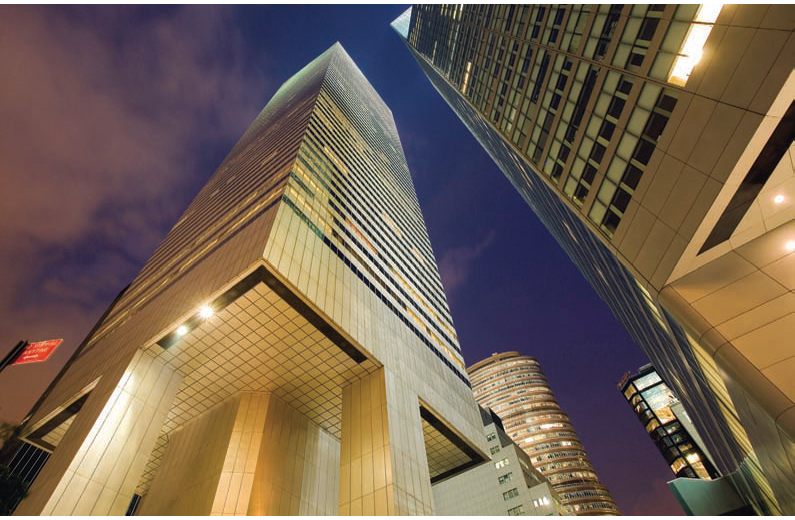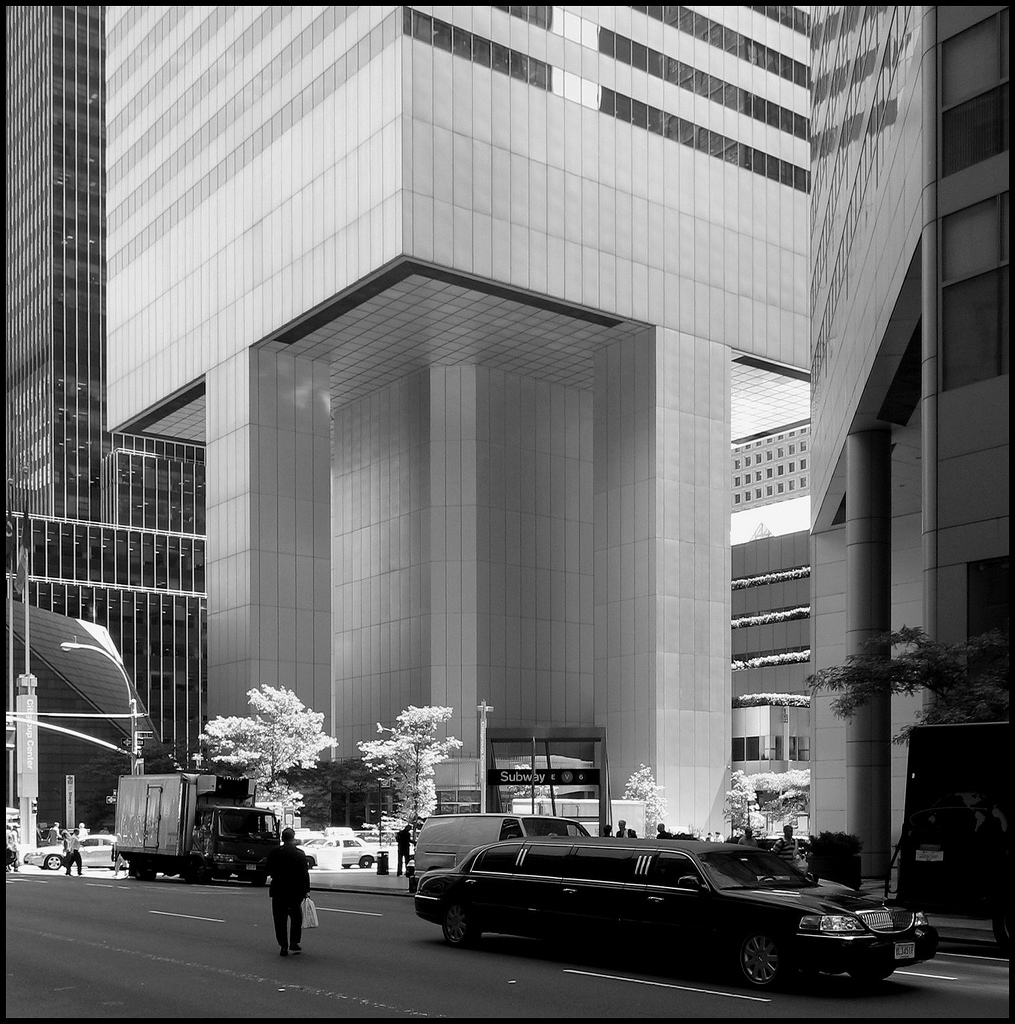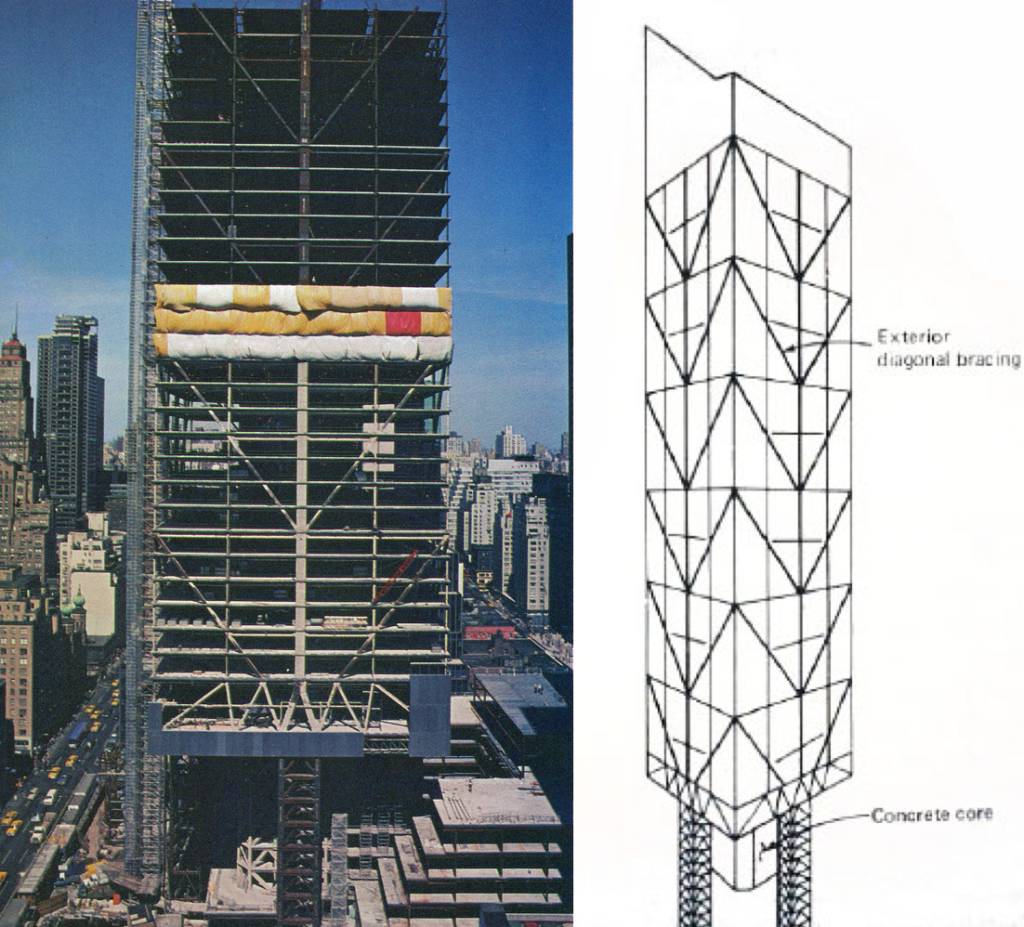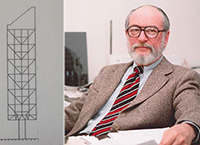
A day in June 1978, one of America’s most respected high-rise structural designers, William LeMesseurier received a phone call from a student in New Jersey. The student was writing a paper on the structural masterpiece, which at the time of completion held the title of the seventh tallest building in the world. Standing at 280m high and 53 storeys, the building consist of 23,000t of steel, clad with glass and reflective aluminium¹.
The student question related to the four, nine storey external columns placed at the centre of each face of the building rather than the corners (Figure 1). According to the student, her professor had said the columns were placed at the wrong locations. LeMesseurier pointed out that the unusual location of the column was deliberate. Rightly so, apart from this arrangement being effective in resisting quarterly winds – winds blowing towards the corner of a building, the scheme called for one of the building’s corner overhangs a church. LeMesseurier, providing the student further information by referring her to a technical article on the building, the call ended¹.

The idea of placing columns midway of each building face was actually to create a 22m overhang over the St Peter’s Lutheran Church located on the same site. During the concept stage of the Citicorp tower, it was agreed that the building will be rebuilt, and located in one of the corners of the tower. The Structural design called for columns placed midface, with six, eight storey high bracing system (shaped in the form of an inverted chevrons), to accommodate wind and the 22m cantilevered overhangs at the building corners – one of which could span the St Peter’s church (Figure 2).
A Design Error
Coincidentally at the time of receiving that phone call from the student, William LeMesseurier was an adjunct professor at Harvard and MIT, thus, he decided that, this would form an interesting topic, to discuss the building’s rather unusual bracing system with his engineering students. It is also important to note that, at the time, there was no requirement for checking quarterly winds, thus only perpendicular winds might have considered in the design. This is evident in New York’s building code at the time. However, when LeMesseurier set out to calculate the forces on the bracings, he decided to also do so for quarterly winds. What was discovered was staggering and extremely chilling, in what would lead to a string of events that were kept secret for almost 20 years.

To begin, the steel bracings were not just required for lateral stability as is normally the case with most steel structures, but to also resist half of the vertical loads on the structure. This meant that the connections in the bracings would be sensitive to changes in tensile loading. LeMesseurier began is calculations, estimating the perpendicular winds, after which he then did for the quarterly wind. This is a purely intellectual exercise, as it was generally believed that, if a building can withstand perpendicular wind, it should be able to withstand quarterly winds as well. How ironic that, the reverse would come to be the case of the Citicorp tower due to the innovative bracing system used.
The calculations showed that the quarterly wind increased the forces by 40% in 50% of the chevrons. The news that, the sections used for bracings could safely resist the forces came as a relieve, but there was another problem. The 40% increase in the wind forces in the bracings amplified the forces on the bolted connections by 160%.
LeMesseurier began searching for anything he could use to justify the structural integrity of the building. He factored in the weight of the building’s 370t tuned damper- one of the very first ever installed in a skyscraper but not much changed. To fully unravel the nature of the problem, he scheduled an appointment with the director of the boundary layer wind tunnel laboratory at the University of Ontario whom had undertaken tests at the building design stage. What was found brought even more troubling news. While theoretically the 160% increase was correct, in practice the loading would be much higher because of the potential of the quarterly wind to dynamically excite the flexible structure. In risk terms the information suggested that the structure would fail in a wind storm having a return period of 1 in 16years, a far cry from the 1 in 500years that was envisaged.
In the face of this new information, the hurricane season fast approaching and LeMesseurier realizing the litigation, bankruptcy and professional disgrace that would follow should his fears on this structure come to pass. He opted that the only way out is to blow the whistle on himself. What followed was complex hushed meetings between insurers, lawyers and Citicorp on how to manage the situation¹. If the $175million tower were to collapse up to 200,000 members of the public would be in danger.
The Retrofit Plan
After a series of confidential meetings, LeMesseurier proposed a solution to strengthen 200 bolted connections. The solution called for a 50mm plate to be welded to each splice connection, sort of a band aid solution in its truest sense².
During the conceptual design stage of the Citicorp, LeMesseurier is on record to have told the architect to express the structural beauty of the building by exposing the steel bracings, but the architect declined, this decline would later become an element of the saving grace. Instead of exposing the diagonal bracing, it was clad in fireproofing materials making the bracings features internally visible in several offices². More importantly it meant that the steel bracings were readily accessible for strengthening. LeMesseurier office completed the design and Karl Koch was contacted for the Retrofit works.
With the clock ticking and with all concerned parties at an ethical cross road, the design team decided it’s best not to alert the public, due to the disproportionate amount of panic that would ensue. Instead, a vague press release was issued detailing some very minor maintenance works and strengthening procedures over the months. Coincidentally, all the media houses were on a shut down, due to journalists on strike. Despite their publicly hushed approach to the problem, the team did develop a response plan with the mayor’s office, in the event of a wind alert. The plan called for over 2000 red cross staff to be recruited to evacuate, and provide food and shelter to the almost 200,000 people projected to be affected by the incidence.
Racing Against Time
The Retrofit work was done in utmost secrecy and confidentiality. It was undertaken at nights only. At 5pm carpenters would erect a protective screen around the bolted joints and remove the fire proofing materials. From 8pm welding would commence until 4am the next day, when labourers are brought in to clean up the mess before the first office workers arrived. Work continued, 7 days a week, with the building department fast-tracking the certification of welders to meet the shortfall of trained personnel.
Work continued with speed and utmost dedication, but on the 1st of September, the news that everybody has being dredging arrived. The Hurricane, ‘Ella’, was heading for New York City. LeMesseurier recalled that even though most critical joint had been fixed and an alternative power source had been provided for the tuned damper, he worried that they might probably have to hit the panic button. But a few hours later the hurricane changed direction and began heading out to the sea.
About a month later, the building was completed. Thanks to LeMesseurier engineers, Citicorp, City officials, a team of carpenters, welders and laborer’s and $4.3million to increase the wind resistance of the building from a 1 in 16yrs to a 1 in 700yr event – a building still considered to have one of the best wind rating all over the world.
Aftermath & Lessons
As expected, all hands were on deck to fix the problem, but once the problem was fixed, the inescapable legal tussle was about to begin. With Citicorp commencing legal action against LeMesseurier and the architect, seeking indemnity for all cost incurred in undertaking the strengthening works. LeMesseurier instead offered Citicorp $2million which was the value of his insurance policy, it was accepted and there was no further litigation. This storey remained hidden until 1995, when it was first broken by a journalist, Joe Morgenstern for the New Yoker Magazine3.
There are always lessons to learn from engineering failures, just because this wasn’t catastrophic doesn’t make it an exception. Since the story hit the limelight in 1995, LeMesseurier has being hailed for his ethical conduct, he found an error, owned up to his own mistakes and found a way to fix it. However, there are still some ethical concerns that relates to his conduct. He was technically guilty of professional negligence. For example, when the design was being conceived, it was agreed that each chevron would be welded together, but the steel supplier proposed cheaper bolted connections, instead of welded connections. This design change was approved by LeMesseurier design office, with LeMesseurier himself unaware of this change until a month prior to receiving that student’s call. Had they stuck with the initially proposed welded connection, the wind force on the connection would’ve still increased by 160% nonetheless the joints would’ve been safe. This was proved by LeMesseurier’s himself.
Also, when Hurricane Ella threatened the city, plans for evacuations were made in clandestine and hesitation, subjecting the public to a potential danger that could get out of hands. Finally, and most subtly, the advancement of professional knowledge was almost denied by concealing this knowledge had it not being leaked by the New Yoker journalist.
However, overall, the conduct of LeMesseurier is commendable, at least, this is far from the case of the engineer on the Hartford Civic Centre, who disregarded every warning of bad design at every level on the grounds that a state-of-the-art software was in use, in LeMesseurier case he owned up to the mistakes and approached the problem with the precision of a structural engineer.
I was constantly calculating which joint to fix next, which level of the building was more critical, and I developed charts and graphs of all the consequences: if you fix this, then the rarity of the storm that will cause any trouble lengthens to that.
William LeMesseurier
Also, the confidentiality and dexterity of the team should not go unnoticed, imagine carrying out a major structural strengthening operation in a building for months, and the occupants weren’t even aware of the significance of what’s going on. This is a masterclass in how to clean a mess.

Over the years, LeMesseurier would discuss this crisis in his Harvard course and he reminds his students that ‘You have a social obligation. In return for getting a license and being regarded with respect, you’re supposed to be self-sacrificing and look beyond the interest of yourself and your client to society as a whole. And the most wonderful part of my story is that when I did it nothing bad happened’³. This is the most significant lesson of this story.
See: Human Frailty vs Automation: Lessons from the 2014 Galactic Air crash
Thank you for reading
Sources & Citation
- Kremer E. (2002) ‘(Re)examining the Citicorp case: Ethical paragon or chimera’ [Online] Available at: www.crosscurrents.org/kremer2002.htm (Accessed: October 2021)
- Morgenstern J. (1997) ‘The Fifty-Nine-Story Crisis’, J. Prof. Issues Eng. Educ. Pract., 123 (1), pp. 23–29
- Brady S. (2014) ‘Citicorp Centre Tower: Failure Averted’, The Structural Engineer, Professional Guidance Notes 72(6), pp 14-15
- Leeuwen R.V. (2017) ‘Citicorp Centre: A close call’, Blogpost.
